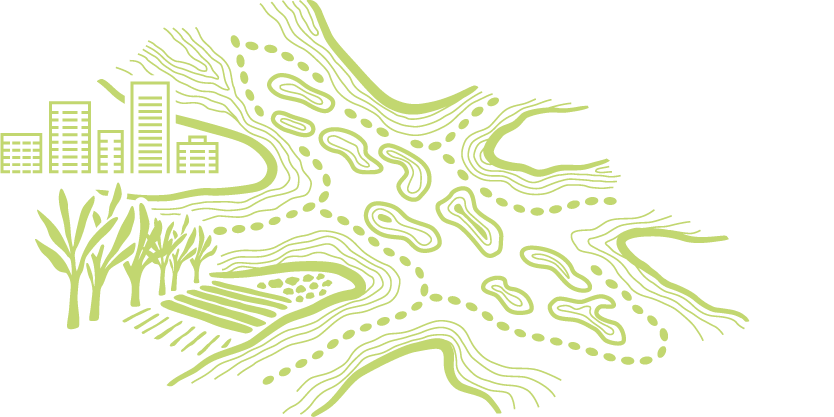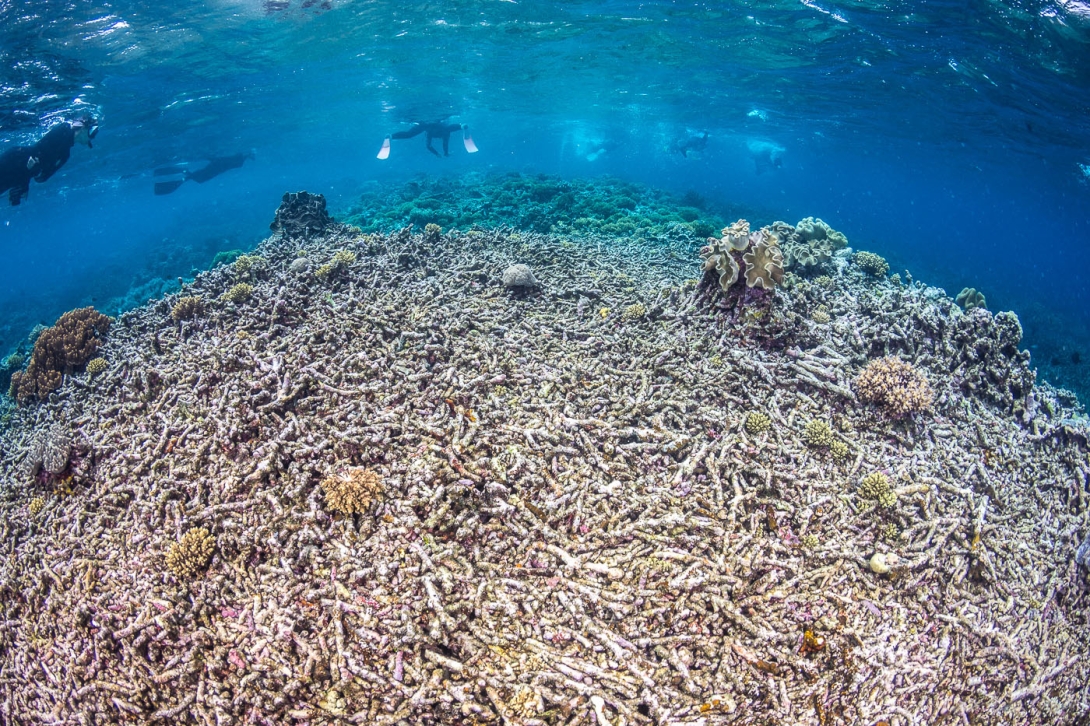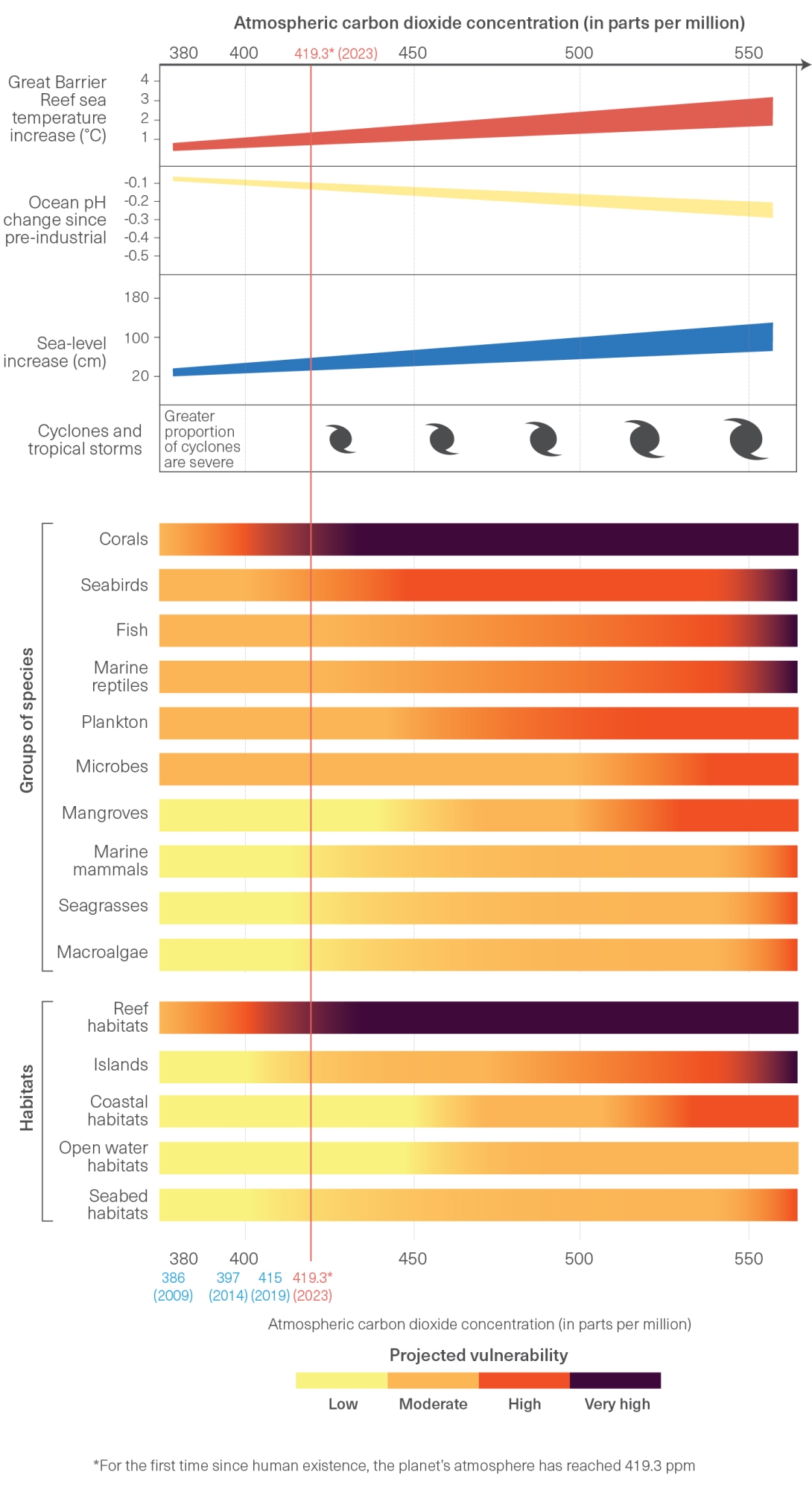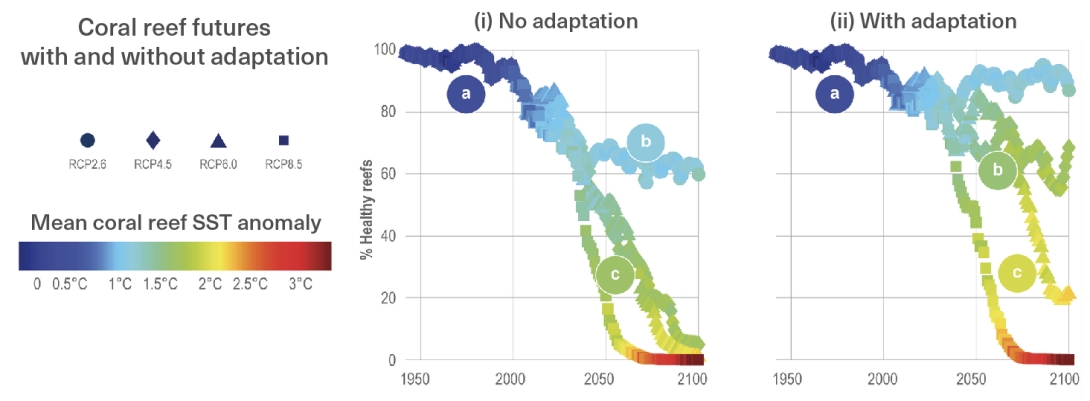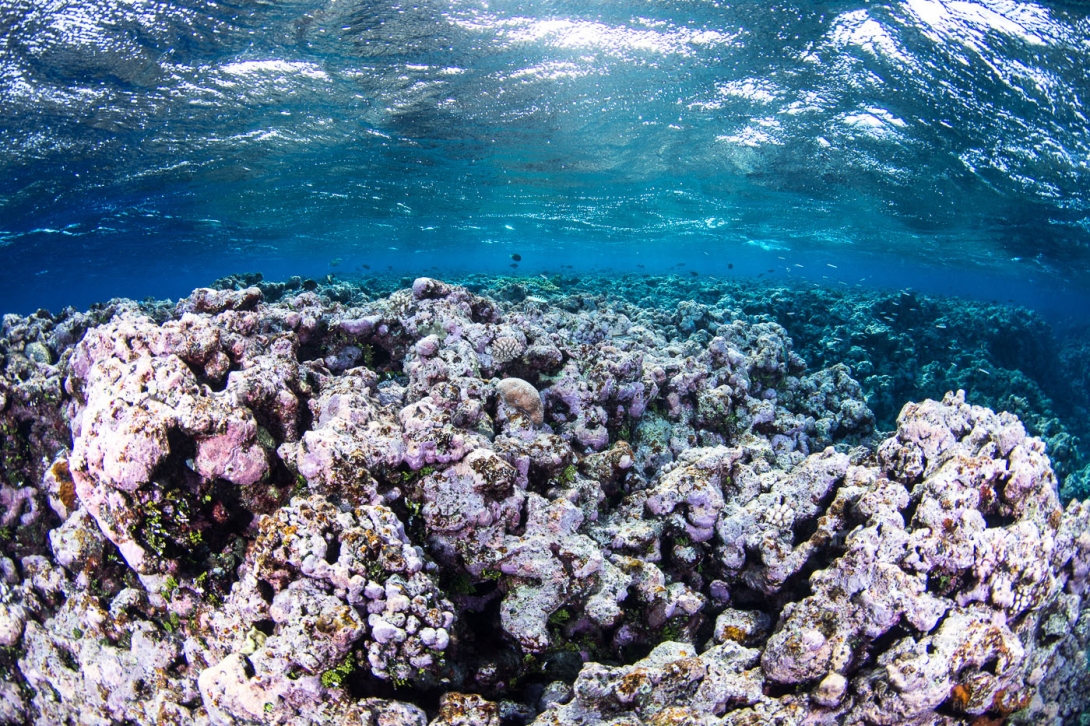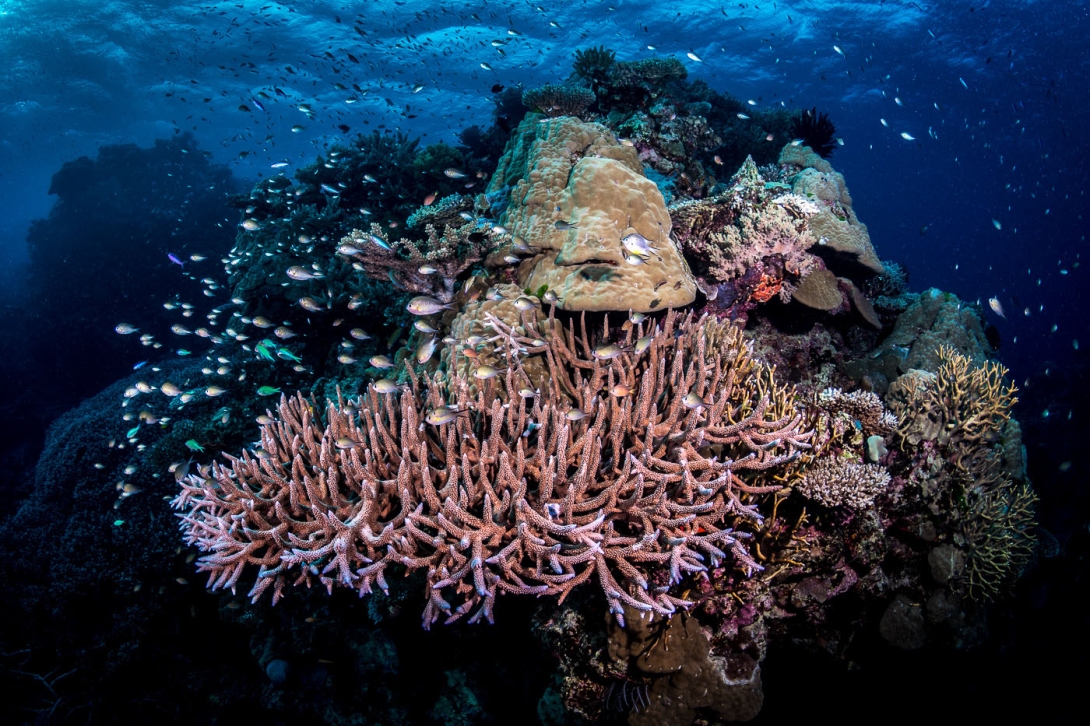95.
Saintilan, N., Horton, B., Törnqvist, T.E., Ashe, E.L., Khan, N.S., et al. 2023, Widespread retreat of coastal habitat is likely at warming levels above 1.5 °C, Nature 621(7977): 112-119.
100.
Hamylton, S.M., McLean, R., Lowe, M. and Adnan, F.A.F. 2019, Ninety years of change on a low wooded island, Great Barrier Reef, Royal Society Open Science 6(6): 181314.
109.
Cooley, S.R., Schoeman, D.S., Bopp, L., Boyd, P., Donner, S., et al. 2022, Oceans and coastal ecosystems and their services, in Climate Change 2022: Impacts, Adaptation and Vulnerability. Contribution of Working Group II to the Sixth Assessment Report of the Intergovernmental Panel on Climate Change Cambridge University Press, Cambridge, UK and New York, USA, pp. 379-550.
133.
York, P.H., Macreadie, P.I. and Rasheed, M.A. 2018, Blue Carbon stocks of Great Barrier Reef deep-water seagrasses, Biology Letters 14(12): 20180529.
153.
Harris, D.L., Rovere, A., Casella, E., Power, H., Canavesio, R., et al. 2018, Coral reef structural complexity provides important coastal protection from waves under rising sea levels, Science Advances 4(2): eaao4350.
158.
Cheung, M.W.M., Hock, K., Skirving, W. and Mumby, P.J. 2018, Cumulative bleaching undermines systemic resilience of the Great Barrier Reef, Marine Ecology Progress Series 604(23): 263-268.
159.
McWhorter, J.K., Halloran, P.R., Roff, G., Skirving, W.J., Perry, C.T., et al. 2022, The importance of 1.5°C warming for the Great Barrier Reef, Global Change Biology 28(4): 1332-1341.
163.
Australian Institute of Marine Science 2023, A pause in recent coral recovery across most of the Great Barrier Reef. Annual summary report of the Great Barrier Reef coral condition 2022/23, Australian Institute of Marine Science, Townsville.
165.
Hoegh-Guldberg, O., Skirving, W., Dove, S.G., Spady, B.L., Norrie, A., et al. 2023, Coral reefs in peril in a record-breaking year, Science 382(6676): 1238-1240.
180.
McWhorter, J.K., Halloran, P.R., Roff, G. and Mumby, P.J. 2024, Climate change impacts on mesophotic regions of the Great Barrier Reef, Proceedings of the National Academy of Sciences 121(16): e2303336121.
181.
Galbraith, G.F., Cresswell, B.J., McCormick, M.I., Bridge, T.C. and Jones, G.P. 2022, Contrasting hydrodynamic regimes of submerged pinnacle and emergent coral reefs, PLoS One 17(8): e0273092.
187.
Matthews, S.A., Williamson, D.H., Beeden, R., Emslie, M.J., Abom, R.T.M., et al. 2024, Protecting Great Barrier Reef resilience through effective management of crown-of-thorns starfish outbreaks, PLoS One 19(4): e0298073.
203.
Pitcher, C.R., Doherty, P., Arnold, P., Hooper, J., Gribble, N.A., et al. 2007, Seabed Biodiversity on the Continental Shelf of the Great Barrier Reef World Heritage Area: final report to the Cooperative Research Centre for the Great Barrier Reef World Heritage Area. AIMS/CSIRO/QM/QDPI CRC Reef Research Task Final Report, CSIRO Marine and Atmospheric Research, Hobart.
246.
Huang, Z., Feng, M., Dalton, S.J. and Carroll, A.G. 2024, Marine heatwaves in the Great Barrier Reef and Coral Sea: their mechanisms and impacts on shallow and mesophotic coral ecosystems, Science of The Total Environment 908: 1-20.
252.
Benthuysen, J.A., Emslie, M.J., Currey-Randall, L.M., Cheal, A.J. and Heupel, M.R. 2022, Oceanographic influences on reef fish assemblages along the Great Barrier Reef, Progress in Oceanography 208: 102901.
254.
Booth, D.J. and Beretta, G.A. 2002, Changes in a fish assemblage after a coral bleaching event, Marine Ecology Progress Series 245: 205-212.
281.
Smith, J.N., Mongin, M., Thompson, A., Jonker, M.J., De'ath, G., et al. 2020, Shifts in coralline algae, macroalgae, and coral juveniles in the Great Barrier Reef associated with present-day ocean acidification, Global Change Biology 26(4): 2149-2160.
322.
Stella, J.S., Munday, P.L. and Jones, G.P. 2011, Effects of coral bleaching on the obligate coral-dwelling crab Trapezia cymodoce, Coral Reefs 30: 719-727.
323.
Stella, J.S., Munday, P.L., Walker, S.P.W., Pratchett, M.S. and Jones, G.P. 2014, From cooperation to combat: adverse effect of thermal stress in a symbiotic coral-crustacean community, Oecologia 174: 1187-1195.
356.
Richardson, A., Eriksen, R., Moltmann, T., Hodgson-Johnston, I. and Wallis, J.R. 2020, State and Trends of Australia’s Ocean Report, Integrated Marine Observing System, Hobart.
359.
Richardson, A.J., Rochester, W. and Tilbrook, B. 2020, Ocean acidification and calcifying zooplankton, in State and Trends of Australia’s Ocean Report, eds A. Richardson, R. Erikson, T. Moltmann, I. Hodgson-Johnston and J.R. Wallis, Integrated Marine Observing System (IMOS), Hobart.
535.
Fabricius, K., Brown, A., Songcuan, A., Collier, C., Uthicke, S. and Robson, B. 2024, 2022 Scientific Consensus Statement: Summary | Evidence Statement for Question 2.2: What are the current and predicted impacts of climate change on GBR ecosystems (including spatial and temporal distribution of impacts)? in 2022 Scientific Consensus Statement on land-based impacts on Great Barrier Reef water quality and ecosystem condition, eds J. Waterhouse, M. Pineda and K. Sambrook, Commonwealth of Australia and Queensland Government.
536.
IPCC 2023, Climate Change 2023: Synthesis Report. Contribution of Working Groups I, II and III to the Sixth Assessment Report of the Intergovernmental Panel on Climate Change, eds H. Lee and J. Romero IPCC, Geneva, Switzerland: 184.
540.
CSIRO and The Bureau of Meteorology 2022, State of the Climate 2022.
541.
Cheal, A.J., MacNeil, M.A., Emslie, M.J. and Sweatman, H. 2017, The threat to coral reefs from more intense cyclones under climate change, Global Change Biology 23(4): 1511-1524.
544.
Beeden, R., Maynard, J., Puotinen, M., Marshall, P., Dryden, J., et al. 2015, Impacts and recovery from severe Tropical Cyclone Yasi on the Great Barrier Reef, PloS One 10(4): e0121272.
549.
Dixon, A.M., Puotinen, M., Ramsay, H.A. and Beger, M. 2022, Coral reef exposure to damaging tropical cyclone waves in a warming climate, Earth's Future 10(8): e2021EF002600.
554.
Yaddanapudi, R., Mishra, A., Huang, W. and Chowdhary, H. 2022, Compound wind and precipitation extremes in global coastal regions under climate change, Geophysical Research Letters 49(15): e2022GL098974.
555.
Carrigan, A.D. and Puotinen, M. 2014, Tropical cyclone cooling combats region‐wide coral bleaching, Global Change Biology 20(5): 1604-1613.
591.
Lovelock, C.E. and Reef, R. 2020, Variable impacts of climate change on blue carbon, One Earth 3(2): 195-211.
632.
Wang, C., Deser, C., Yu, J., DiNezio, P. and Clement, A. 2017, El Niño and southern oscillation (ENSO): a review, in Coral reefs of the eastern tropical Pacific: persistence and loss in a dynamic environment, eds P.W. Glynn, D.P. Manzello and I.C. Enochs, Springer, Miami, pp. 85-106.
642.
Pezner, A.K., Courtney, T.A., Barkley, H.C., Chou, W., Chu, H., et al. 2023, Increasing hypoxia on global coral reefs under ocean warming, Nature Climate Change 13(4): 403-409.
643.
Hughes, D.J., Alderdice, R., Cooney, C., Kühl, M., Pernice, M., et al. 2020, Coral reef survival under accelerating ocean deoxygenation, Nature Climate Change 10(4): 296-307.
644.
Oliver, E.C., Donat, M.G., Burrows, M.T., Moore, P.J., Smale, D.A., et al. 2018, Longer and more frequent marine heatwaves over the past century, Nature Communications 9(1): 1-12.
657.
Gregoire, M., Gilbert, D., Oschlies, A. and Rose, K. 2019, What is ocean deoxygenation? in Ocean deoxygenation: Everyone’s problem - Causes, impacts, consequences and solutions, eds D. Laffoley and J.M. Baxter, IUCN, Switzerland, pp. 1-21.
664.
Langlais, C.E., Herzfeld, M., Klein, E., Cantin, N., Benthuysen, J., et al. 2021, Oceanographic drivers of bleaching in the GBR: from observations to prediction, Volume 2: 3D Bleaching in the GBR: Development and analysis of a 3D climatology and heat accumulation products using eReefs, Report to the National Environmental Science Program. Reef and Rainforest Research Centre Limited. Cairns (55pp.).
665.
IPCC 2021, Climate Change 2021: The Physical Science Basis. Contribution of Working Group I to the Sixth Assessment Report of the Intergovernmental Panel on Climate Change, Cambridge University Press, Cambridge, UK and New York, NY, USA.
667.
McWhorter, J.K., Halloran, P.R., Roff, G., Skirving, W.J. and Mumby, P.J. 2022, Climate refugia on the Great Barrier Reef fail when global warming exceeds 3° C, Global Change Biology 28(19): 5768-5780.
713.
Tang, W., Llort, J., Weis, J., Perron, M.M., Basart, S., et al. 2021, Widespread phytoplankton blooms triggered by 2019–2020 Australian wildfires, Nature 597(7876): 370-375.
722.
Jackson, R. and Gabric, A. 2022, Climate change impacts on the marine cycling of biogenic sulfur: a review, Microorganisms 10(8): 1581.
739.
Fabricius, K.E., Neill, C., Van Ooijen, E., Smith, J.N. and Tilbrook, B. 2020, Progressive seawater acidification on the Great Barrier Reef continental shelf, Scientific Reports 10(1): 18602.
743.
Anthony, K.R., Kline, D.I., Diaz-Pulido, G., Dove, S. and Hoegh-Guldberg, O. 2008, Ocean acidification causes bleaching and productivity loss in coral reef builders, Proceedings of the National Academy of Sciences 105(45): 17442-17446.
744.
Kuffner, I.B., Andersson, A.J., Jokiel, P.L., Rodgers, K.S. and Mackenzie, F.T. 2008, Decreased abundance of crustose coralline algae due to ocean acidification, Nature Geoscience 1(2): 114-117.
749.
Davis, K.L., Colefax, A.P., Tucker, J.P., Kelaher, B.P. and Santos, I.R. 2021, Global coral reef ecosystems exhibit declining calcification and increasing primary productivity, Communications Earth & Environment 2(1): 105.
757.
Wolfe, K., Deaker, D.J., Graba-Landry, A., Champion, C., Dove, S., et al. 2021, Current and future trophic interactions in tropical shallow-reef lagoon habitats, Coral Reefs 40: 83-96.
758.
Cyronak, T. and Eyre, B.D. 2016, The synergistic effects of ocean acidification and organic metabolism on calcium carbonate (CaCO3) dissolution in coral reef sediments, Marine Chemistry 183: 1-12.
776.
Szilagyi, Z., Webster, J.M., Patterson, M.A., Hips, K., Riding, R., et al. 2020, Controls on the spatio-temporal distribution of microbialite crusts on the Great Barrier Reef over the past 30,000 years, Marine Geology 429: 106312.
781.
Williams, J., Pettorelli, N., Hartmann, A.C., Quinn, R.A., Plaisance, L., et al. 2024, Decline of a distinct coral reef holobiont community under ocean acidification, Microbiome 12(1): 75.
884.
Hopley, D. and Smithers, S. 2019, Geomorphology of coral reefs with special reference to the Great Barrier Reef, in The Great Barrier Reef: Biology, Environment and Management, eds P. Hutchings, M.J. Kingsford and O. Hoegh-Guldberg, 2nd edn, CSIRO Publishing, Clayton, Australia, pp. 9–24.
898.
McMahon, A., Santos, I.R., Schulz, K.G., Scott, A., Silverman, J., et al. 2019, Coral reef calcification and production after the 2016 bleaching event at Lizard Island, Great Barrier Reef, Journal of Geophysical Research: Oceans 124(6): 4003-4016.
932.
Figueiredo, J., Thomas, C.J., Deleersnijder, E., Lambrechts, J., Baird, A.H., et al. 2022, Global warming decreases connectivity among coral populations, Nature Climate Change 12(1): 83-87.
968.
Hines, H.B., Brooke, M., Wilson, J., McDonald, W. and Hargreaves, J. 2020, The extent and severity of the Mackay highlands 2018 wildfires and the potential impact on natural values, particularly in the mesic forests of the Eungella-Crediton area, Proceedings of The Royal Society of Queensland 125: 139-157.
1015.
Castro‐Sanguino, C., Bozec, Y., Condie, S.A., Fletcher, C.S., Hock, K., et al. 2023, Control efforts of crown‐of‐thorns starfish outbreaks to limit future coral decline across the Great Barrier Reef, Ecosphere 14(6): e4580.
1030.
Gervais, C.R., Champion, C. and Pecl, G.T. 2021, Species on the move around the Australian coastline: A continental‐scale review of climate‐driven species redistribution in marine systems, Global Change Biology 27(14): 3200-3217.
1539.
Trewin, B., Morgan-Bulled, D. and Cooper, S. 2021, Australia State of the Environment 2021: Climate. Independent report to the Australian Government Minister for the Environment, DCCEEW, Canberra.
1549.
Morice, C.P., Kennedy, J.J., Rayner, N.A., Winn, J.P., Hogan, E., et al. 2021, An updated assessment of near‐surface temperature change from 1850: The HadCRUT5 data set, Journal of Geophysical Research: Atmospheres 126(3): e2019JD032361.
1572.
Trebilco, R., Fischer, M., Hunter, C., Hobday, A., Thomas, L., et al. 2021, Australia State of the Environment 2021: Marine. Independent report to the Australian Government Minister for the Environment, DCCEEW, Canberra.
1575.
Seneviratne, S.I., Zhang, X., Adnan, M., Badi, W., Dereczynski, C., et al. 2021, Weather and Climate Extreme Events in a Changing Climate, in Climate Change 2021: The Physical Science Basis. Contribution of Working Group I to the Sixth Assessment Report of the Intergovernmental Panel on Climate Change, eds V. Masson-Delmotte, P. Zhai, A. Pirani, S.L. Connors, C. Péan, et al., Cambridge University Press, Cambridge, United Kingdom and New York, NY, USA, pp. 1513–1766.
1604.
Hughes, T.P., Anderson, K.D., Connolly, S.R., Heron, S.F., Kerry, J.T., et al. 2018, Spatial and temporal patterns of mass bleaching of corals in the Anthropocene, Science 359(6371): 80-83.
1605.
Downie, A.T., Cramp, R.L. and Franklin, C.E. 2024, The interactive impacts of a constant reef stressor, ultraviolet radiation, with environmental stressors on coral physiology, Science of the Total Environment 907: 168066.
1606.
Elledge, A. and Thornton, C. 2017, Effect of changing land use from virgin brigalow (Acacia harpophylla) woodland to a crop or pasture system on sediment, nitrogen and phosphorus in runoff over 25 years in subtropical Australia, Agriculture, Ecosystems & Environment 239: 119-131.
-
1608.
Laubenstein, T., Smith, T.F., Hobday, A.J., Pecl, G.T., Evans, K., et al. 2023, Threats to Australia's oceans and coasts: A systematic review, Ocean & Coastal Management 231: 106331.
1609.
IPCC 2021, Summary for Policymakers, in Climate Change 2021: The Physical Science Basis. Contribution of Working Group I to the Sixth Assessment Report of the Intergovernmental Panel on Climate Change, eds V. Masson-Delmotte, P. Zhai, A. Pirani, S.L. Connors, C. Péan, et al., Cambridge University Press, Cambridge, United Kingdom and New York, NY, USA, pp. 3−32.
1610.
Lovelock, C.E., Ellison, J.C., Johnson, J.E. and Marshall, P.A. 2007, Climate change and the Great Barrier Reef: A vulnerability assessment, Great Barrier Reef Marine Park Authority, Townsville.
1611.
Hoegh-Guldberg, O., Jacob, D., Taylor, M., Bindi, M., Brown, S., et al. 2018, Impacts of 1.5ºC global warming on natural and human systems, in Global warming of 1.5°C. An IPCC special report on the impacts of global warming of 1.5°C above pre-industrial levels and related global greenhouse gas emission pathways, in the context of dtrengthening the global response to the threat of climate change, sustainable development, and efforts to eradicate poverty, eds V. Masson-Delmotte, P. Zhai, H.O. Pörtner, D. Roberts, J. Skea, et al., World Meteorological Organization, Geneva, pp. 175-311.
1612.
Eddy, T.D., Lam, V.W.Y., Reygondeau, G., Cisneros-Montemayor, A.M., Greer, K., et al. 2021, Global decline in capacity of coral reefs to provide ecosystem services, One Earth 4(9): 1278-1285.
1613.
Ferrario, F., Beck, M.W., Storlazzi, C.D., Micheli, F., Shepard, C.C., et al. 2014, The effectiveness of coral reefs for coastal hazard risk reduction and adaptation, Nature Communications 5(1): 3794.
1614.
Carlson, R.R., Evans, L.J., Foo, S.A., Grady, B.W., Li, J., et al. 2021, Synergistic benefits of conserving land-sea ecosystems, Global Ecology and Conservation 28: e01684.
1615.
Jokiel, P.L. and Coles, S.L. 1990, Response of Hawaiian and other Indo-Pacific reef corals to elevated temperature, Coral Reefs 8: 155-162.
1616.
Stuart-Smith, R.D., Brown, C.J., Ceccarelli, D.M. and Edgar, G.J. 2018, Ecosystem restructuring along the Great Barrier Reef following mass coral bleaching, Nature 560(7716): 92-96.
1617.
Richardson, L.E., Graham, N.A.J., Pratchett, M.S., Eurich, J.G. and Hoey, A.S. 2018, Mass coral bleaching causes biotic homogenization of reef fish assemblages, Global Change Biology 24(7): 3117-3129.
1618.
Holbrook, N.J., Claar, D.C., Hobday, A.J., McInnes, K.L., Oliver, E.C., Gupta, A.S., Widlansky, M.J. and Zhang, X. 2020, ENSO‐driven ocean extremes and their ecosystem impacts, in El Niño Southern Oscillation in a changing climate, eds M.J. McPhaden, A.Santosi and W. Cai, American Geophysical Union, Washington, pp. 409-428.
1619.
Chaudhary, C., Alfaro-Lucas, J.M., Simões, M.V.P., Brandt, A. and Saeedi, H. 2023, Potential geographic shifts in the coral reef ecosystem under climate change, Progress in Oceanography 213: 103001.
1620.
Kim, S.W., Sampayo, E.M., Sommer, B., Sims, C.A., Gómez‐Cabrera, M.D.C., et al. 2019, Refugia under threat: Mass bleaching of coral assemblages in high‐latitude eastern Australia, Global Change Biology 25(11): 3918-3931.
1621.
Bay, L.K. and Howells, E.J. 2021, Mapping the future for coral reefs, eLife 10: e72978.
1622.
Anthony, K., Bowen, J., Mead, D. and Hardisty, P.E. 2019, Reef Restoration and Adaptation Program: Intervention Analysis and Recommendations. A report provided to the Australian Government by the Reef Restoration and Adaptation Program.
1623.
Logan, C.A., Dunne, J.P., Ryan, J.S., Baskett, M.L. and Donner, S.D. 2021, Quantifying global potential for coral evolutionary response to climate change, Nature Climate Change 11(6): 537-542.
1624.
Mead, D., Bay, L.K., Anthony, K., Hussey, K., Taylor, B., et al. 2019, Reef Restoration and Adaptation Program: Research and Development Program. A report provided to the Australian Government by the Reef Restoration and Adaptation Program.
1625.
Kleypas, J.A., McManus, J.W. and Meñez, L.A. 1999, Environmental limits to coral reef development: where do we draw the line? American Zoologist 39(1): 146-159.
1626.
Bell, J.J., Davy, S.K., Jones, T., Taylor, M.W. and Webster, N.S. 2013, Could some coral reefs become sponge reefs as our climate changes? Global Change Biology 19(9): 2613-2624.
1627.
Ramsby, B.D., Hoogenboom, M.O., Smith, H.A., Whalan, S. and Webster, N.S. 2018, The bioeroding sponge Cliona orientalis will not tolerate future projected ocean warming, Scientific Reports 8(1): 8302.
1628.
Perkins, N.R., Monk, J., Soler, G., Gallagher, P. and Barrett, N.S. 2022, Bleaching in sponges on temperate mesophotic reefs observed following marine heatwave events, Climate Change Ecology 3: 100046.
1629.
Abdul Wahab, M.A., De Nys, R., Webster, N. and Whalan, S. 2014, Phenology of sexual reproduction in the common coral reef sponge, Carteriospongia foliascens, Coral Reefs 33: 381-394.
1630.
Massaro, A.J., Weisz, J.B., Hill, M.S. and Webster, N.S. 2012, Behavioral and morphological changes caused by thermal stress in the Great Barrier Reef sponge Rhopaloeides odorabile, Journal of Experimental Marine Biology and Ecology 416: 55-60.
1631.
Ryan, M.G. 1991, Effects of climate change on plant respiration, Ecological Applications 1(2): 157–167.
1632.
Campbell, S.J., McKenzie, L.J. and Kerville, S.P. 2006, Photosynthetic responses of seven tropical seagrasses to elevated seawater temperature, Journal of Experimental Marine Biology and Ecology 330(2): 455-468.
1633.
Collier, C.J., Uthicke, S. and Waycott, M. 2011, Thermal tolerance of two seagrass species at contrasting light levels: implications for future distribution in the Great Barrier Reef, Limnology and Oceanography 56(6): 2200-2210.
1634.
Arias-Ortiz, A., Serrano, O., Masqué, P., Lavery, P.S., Mueller, U., et al. 2018, A marine heatwave drives massive losses from the world’s largest seagrass carbon stocks, Nature Climate Change 8(4): 338-344.
1635.
Collier, C.J. and Waycott, M. 2014, Temperature extremes reduce seagrass growth and induce mortality, Marine Pollution Bulletin 83(2): 483-490.
1636.
Pendleton, L., Donato, D.C., Murray, B.C., Crooks, S., Jenkins, W.A., et al. 2012, Estimating global “blue carbon” emissions from conversion and degradation of vegetated coastal ecosystems, PloS One 7(9): e43542.
1637.
Vermeij, G.J. 1978, Biogeography and adaptation: patterns of marine life, Harvard University Press, Cambridge, UK.
1638.
Pörtner, H.O. and Farrell, A.P. 2008, Physiology and climate change, Science 322(5902): 690-692.
1639.
McLeod, I.M., McCormick, M.I., Munday, P.L., Clark, T.D., Wenger, A.S., et al. 2015, Latitudinal variation in larval development of coral reef fishes: implications of a warming ocean, Marine Ecology Progress Series 521: 129-141.
1640.
Takahashi, M., McCormick, M.I., Munday, P.L. and Jones, G.P. 2012, Influence of seasonal and latitudinal temperature variation on early life-history traits of a coral reef fish, Marine and Freshwater Research 63(10): 856-864.
1641.
Munday, P.L., Kingsford, M.J., O’Callaghan, M. and Donelson, J.M. 2008, Elevated temperature restricts growth potential of the coral reef fish Acanthochromis polyacanthus, Coral Reefs 27: 927-931.
1642.
Nilsson, G.E., Crawley, N., Lunde, I.G. and Munday, P.L. 2009, Elevated temperature reduces the respiratory scope of coral reef fishes, Global Change Biology 15(6): 1405-1412.
1643.
Madin, J.S., Baird, A.H., Bridge, T.C.L., Connolly, S.R., Zawada, K.J.A., et al. 2018, Cumulative effects of cyclones and bleaching on coral cover and species richness at Lizard Island, Marine Ecology Progress Series 604: 263-268.
1644.
Richards, Z.T., Juszkiewicz, D.J., Hoggett, A. 2021, Spatio-temporal persistence of scleractinian coral species at Lizard Island, Great Barrier Reef, Coral Reefs 40(4): 1369-1378.
1645.
Johansen, J.L., Messmer, V., Coker, D.J., Hoey, A.S. and Pratchett, M.S. 2014, Increasing ocean temperatures reduce activity patterns of a large commercially important coral reef fish, Global Change Biology 20(4): 1067-1074.
1646.
Pratchett, M.S., Cameron, D.S., Donelson, J., Evans, L., Frisch, A.J., et al. 2017, Effects of climate change on coral grouper (Plectropomus spp.) and possible adaptation options, Reviews in Fish Biology and Fisheries 27(2): 297-316.
1647.
Messmer, V., Pratchett, M.S., Hoey, A.S., Tobin, A.J., Coker, D.J., et al. 2017, Global warming may disproportionately affect larger adults in a predatory coral reef fish, Global Change Biology 23(6): 2230-2240.
1648.
Millington, R.C., Rogers, A., Cox, P., Bozec, Y. and Mumby, P.J. 2022, Combined direct and indirect impacts of warming on the productivity of coral reef fishes, Ecosphere 13(7): e4108.
1649.
Elma, E., Gullström, M., Yahya, S.A., Jouffray, J., East, H.K., et al. 2023, Post-bleaching alterations in coral reef communities, Marine Pollution Bulletin 186: 114479.
1650.
Wismer, S., Tebbett, S.B., Streit, R.P. and Bellwood, D.R. 2019, Spatial mismatch in fish and coral loss following 2016 mass coral bleaching, Science of the Total Environment 650: 1487-1498.
1651.
Lönnstedt, O.M. and Frisch, A.J. 2014, Habitat bleaching disrupts threat responses and persistence in anemonefish, Marine Ecology Progress Series 517: 265-270.
1652.
Pratchett, M.S., Wilson, S.K., Berumen, M.L. and McCormick, M.I. 2004, Sublethal effects of coral bleaching on an obligate coral feeding butterflyfish, Coral Reefs 23: 352-356.
1653.
Harvey, B.P., Marshall, K.E., Harley, C.D. and Russell, B.D. 2022, Predicting responses to marine heatwaves using functional traits, Trends in Ecology & Evolution 37(1): 20-29.
1654.
Jensen, M.P., Allen, C.D., Eguchi, T., Bell, I.P., LaCasella, E.L., et al. 2018, Environmental warming and feminization of one of the largest sea turtle populations in the world, Current Biology 28(1): 154-159. e4.
1655.
Santidrián Tomillo, P. and Spotila, J.R. 2020, Temperature‐dependent sex determination in sea turtles in the context of climate change: uncovering the adaptive significance, BioEssays 42(11): 2000146.
1656.
Lockley, E.C. and Eizaguirre, C. 2021, Effects of global warming on species with temperature‐dependent sex determination: Bridging the gap between empirical research and management, Evolutionary Applications 14(10): 2361-2377.
1657.
Patrício, A.R., Hawkes, L.A., Monsinjon, J.R., Godley, B.J. and Fuentes, M.M. 2021, Climate change and marine turtles: Recent advances and future directions, Endangered Species Research 44: 363-395.
1658.
Poloczanska, E.S., Brown, C.J., Sydeman, W.J., Kiessling, W., Schoeman, D.S., et al. 2013, Global imprint of climate change on marine life, Nature Climate Change 3: 919-925.
1659.
Bunce, A. 2015, Foraging behaviour of a declining population of brown boobies (Sula leucogaster) breeding on the Swain Reefs, Great Barrier Reef, Emu - Austral Ornithology 115(4): 368-372.
1660.
Smithers, B.V., Peck, D.R., Krockenberger, A.K. and Congdon, B.C. 2003, Elevated sea-surface temperature, reduced provisioning and reproductive failure of wedge-tailed shearwaters (Puffinus pacificus) in the southern Great Barrier Reef, Australia, Marine and Freshwater Research 54(8): 973-977.
1661.
Dyer, P.K., O'Neill, P. and Hulsman, K. 2005, Breeding numbers and population trends of Wedge-tailed Shearwater (Puffinus pacificus) and Black Noddy (Anous minutus) in the Capricornia Cays, southern Great Barrier Reef, Emu-Austral Ornithology 105(3): 249-257.
1662.
Brown, S.C., Mellin, C., García Molinos, J., Lorenzen, E.D. and Fordham, D.A. 2022, Faster ocean warming threatens richest areas of marine biodiversity, Global Change Biology 28(19): 5849-5858.
1663.
Valle, M., Chust, G., del Campo, A., Wisz, M.S., Olsen, S.M., et al. 2014, Projecting future distribution of the seagrass Zostera noltii under global warming and sea level rise, Biological Conservation 170: 74-85.
1664.
Cornwall, C.E., Harvey, B.P., Comeau, S., Cornwall, D.L., Hall‐Spencer, J.M., et al. 2022, Understanding coralline algal responses to ocean acidification: Meta‐analysis and synthesis, Global Change Biology 28(2): 362-374.
1665.
Byrne, M. 2011, Impact of ocean warming and ocean acidification on marine invertebrate life history stages: Vulnerabilities and potential for persistence in a changing ocean, Oceanography and Marine Biology: An annual review 49: 1-42.
1666.
Leung, J.Y., Zhang, S. and Connell, S.D. 2022, Is ocean acidification really a threat to marine calcifiers? A systematic review and meta‐analysis of 980 studies spanning two decades, Small 18(35): 2107407.
1667.
Prazeres, M., Uthicke, S. and Pandolfi, J.M. 2015, Ocean acidification induces biochemical and morphological changes in the calcification process of large benthic foraminifera, Proceedings of the Royal Society B: Biological Sciences 282(1803): 20142782.
1668.
Gold, D.A. and Vermeij, G.J. 2023, Deep resilience: An evolutionary perspective on calcification in an age of ocean acidification, Frontiers in Physiology 14: 1092321.
1669.
Anthony, K.R.N. and Marshall, P. 2012, Coral Reefs, in A marine climate change impacts and adaption report card Australia 2012, eds E.S. Poloczanska, A.J. Hobday and A.J. Richardson, CSIRO, Canberra.
1670.
Riding, R. 2000, Microbial carbonates: the geological record of calcified bacterial–algal mats and biofilms, Sedimentology 47: 179-214.
1671.
Van Hooidonk, R., Maynard, J.A., Manzello, D. and Planes, S. 2014, Opposite latitudinal gradients in projected ocean acidification and bleaching impacts on coral reefs, Global Change Biology 20(1): 103-112.
1672.
Schubert, N., Alvarez-Filip, L. and Hofmann, L.C. 2023, Systematic review and meta-analysis of ocean acidification effects in Halimeda: Implications for algal carbonate production, Climate Change Ecology 4: 100059.
1673.
De Beer, D. and Larkum, A. 2001, Photosynthesis and calcification in the calcifying algae Halimeda discoidea studied with microsensors, Plant, Cell & Environment 24(11): 1209-1217.
1674.
Xu, K. and Gao, K. 2018, Responses of Calcifying Algae to Ocean Acidification, in Aquatic Ecosystems in a Changing Climate CRC Press, pp. 162-173.
1675.
Takahashi, M., Noonan, S., Fabricius, K.E. and Collier, C.J. 2016, The effects of long-term in situ CO2 enrichment on tropical seagrass communities at volcanic vents, ICES Journal of Marine Science 73(3): 876-886.
1676.
Veron, J.E.N. 2008, A Reef in Time: the Great Barrier Reef from Beginning to End, Harvard University Press, Cambridge, USA.
1677.
McInerney, F.A. and Wing, S.L. 2011, The Paleocene-Eocene Thermal Maximum: A perturbation of carbon cycle, climate, and biosphere with implications for the future, Annual Review of Earth and Planetary Sciences 39: 489-516.
1678.
Honisch, B., Ridgwell, A., Schmidt, D.N., Thomas, E., Gibbs, S.J., et al. 2012, The geological record of ocean acidification, Science 335(6072): 1058-1063.
1679.
Perry, C.T., Alvarez-Filip, L., Graham, N.A., Mumby, P.J., Wilson, S.K., et al. 2018, Loss of coral reef growth capacity to track future increases in sea level, Nature 558(7710): 396-400.
1680.
Lovelock, C.E., Cahoon, D.R., Friess, D.A., Guntenspergen, G.R., Krauss, K.W., et al. 2015, The vulnerability of Indo-Pacific mangrove forests to sea-level rise, Nature 526: 559-563.
1681.
Nicholls, R.J., Brown, S., Goodwin, P., Wahl, T., Lowe, J., et al. 2018, Stabilization of global temperature at 1.5°C and 2.0°C: implications for coastal areas, Philosophical Transactions of the Royal Society A 376(2119): 20160448.
1682.
Morgan, K.M., Perry, C.T., Arthur, R., Williams, H.T. and Smithers, S.G. 2020, Projections of coral cover and habitat change on turbid reefs under future sea-level rise, Proceedings of the Royal Society B 287(1929): 20200541.
1683.
Sengupta, M., Ford, M.R., Kench, P.S. and Perry, G.L. 2023, Drivers of shoreline change on Pacific coral reef islands: linking island change to processes, Regional Environmental Change 23(3): 110.
1684.
McLean, R. and Kench, P. 2015, Destruction or persistence of coral atoll islands in the face of 20th and 21st century sea‐level rise? Wiley Interdisciplinary Reviews: Climate Change 6(5): 445-463.
1685.
Rama, H., Roberts, D., Tignor, M., Poloczanska, E.S., Mintenbeck, K., Alegría, A., Craig, M., Langsdorf, S., Löschke, S., Möller, V., Okem, A., Rama, B. and Ayanlade, S. 2022, Climate Change 2022: Impacts, Adaptation and Vulnerability Working Group II Contribution to the Sixth Assessment Report of the Intergovernmental Panel on Climate Change, .
1686.
Leo, K.L., Gillies, C.L., Fitzsimons, J.A., Hale, L.Z. and Beck, M.W. 2019, Coastal habitat squeeze: A review of adaptation solutions for saltmarsh, mangrove and beach habitats, Ocean & Coastal Management 175: 180-190.
1687.
Short, F.T., Kosten, S., Morgan, P.A., Malone, S. and Moore, G.E. 2016, Impacts of climate change on submerged and emergent wetland plants, Aquatic Botany 135: 3-17.
1688.
Lovelock, C.E., Feller, I.C., Reef, R., Hickey, S. and Ball, M.C. 2017, Mangrove dieback during fluctuating sea levels, Scientific Reports 7(1): 1680.
1689.
Duke, N.C., Kovacs, J.M., Griffiths, A.D., Preece, L., Hill, D.J.E., et al. 2017, Large-scale dieback of mangroves in Australia’s Gulf of Carpentaria: a severe ecosystem response, coincidental with an unusually extreme weather event, Marine and Freshwater Research 68(10): 1816-1829.
1690.
Sippo, J.Z., Lovelock, C.E., Santos, I.R., Sanders, C.J. and Maher, D.T. 2018, Mangrove mortality in a changing climate: An overview, Estuarine, Coastal and Shelf Science 215: 241-249.
1691.
Chamberlain, D.A., Phinn, S.R. and Possingham, H.P. 2021, Mangrove forest cover and phenology with landsat dense time series in central Queensland, Australia, Remote Sensing 13(15): 3032.
1692.
Connell, J.H. 1978, Diversity in tropical rain forests and coral reefs, Science 199(4335): 1302-1310.
1693.
Lin, T., Hogan, J.A. and Chang, C. 2020, Tropical cyclone ecology: a scale-link perspective, Trends in Ecology & Evolution 35(7): 594-604.
1694.
Correia, K.M. and Smee, D.L. 2022, A meta-analysis of tropical cyclone effects on seagrass meadows, Wetlands 42(8): 108.
1695.
Krauss, K.W. and Osland, M.J. 2020, Tropical cyclones and the organization of mangrove forests: a review, Annals of Botany 125(2): 213-234.
1696.
De’ath, G., Fabricius, K.E., Sweatman, H. and Puotinen, M. 2012, The 27–year decline of coral cover on the Great Barrier Reef and its causes, Proceedings of the National Academy of Sciences 109(44): 17995-17999.
1697.
Bozec, Y., Hock, K., Mason, R.A., Baird, M.E., Castro‐Sanguino, C., et al. 2022, Cumulative impacts across Australia’s Great Barrier Reef: a mechanistic evaluation, Ecological Monographs 92(1): e01494.
1698.
Done, T.J. 1992, Effects of tropical cyclone waves on ecological and geomorphological structures on the Great Barrier Reef, Continental Shelf Research 12(7-8): 859-872.
1699.
Puotinen, M., Maynard, J.A., Beeden, R., Radford, B. and Williams, G.J. 2016, A robust operational model for predicting where tropical cyclone waves damage coral reefs, Scientific Reports 6(1): 26009.
1700.
Baird, A.H., Álvarez-Noriega, M., Cumbo, V.R., Connolly, S.R., Dornelas, M., et al. 2018, Effects of tropical storms on the demography of reef corals, Marine Ecology Progress Series 606: 29-38.
1701.
Fabricius, K.E., De'Ath, G., Puotinen, M.L., Done, T., Cooper, T.F., et al. 2008, Disturbance gradients on inshore and offshore coral reefs caused by a severe tropical cyclone, Limnology and Oceanography 53(2): 690-704.
1702.
Weeks, S.J., Bakun, A., Steinberg, C.R., Brinkman, R. and Hoegh-Guldberg, O. 2010, The Capricorn Eddy: a prominent driver of the ecology and future of the southern Great Barrier Reef, Coral Reefs 29: 975-985.
1703.
Figueira, W.F. and Booth, D.J. 2010, Increasing ocean temperatures allow tropical fishes to survive overwinter in temperate waters, Global Change Biology 16: 506-516.
1704.
Brown, C.J., O'Connor, M.I., Poloczanska, E.S., Schoeman, D.S., Buckley, L.B., et al. 2016, Ecological and methodological drivers of species’ distribution and phenology responses to climate change, Global Change Biology 22(4): 1548-1560.
1705.
Verges, A., Steinberg, P.D., Hay, M.E., Poore, A.G., Campbell, A.H., et al. 2014, The tropicalization of temperate marine ecosystems: climate-mediated changes in herbivory and community phase shifts, Proceedings of the Royal Society of London Series B: Biological Sciences 281(1789): 20140846.
1706.
Cameron, K.A. and Harrison, P.L. 2016, Patterns of scleractinian coral recruitment at Lord Howe Island, an isolated subtropical reef off eastern Australia, Coral Reefs 35: 555-564.
1707.
Ling, S.D. and Johnson, C.R. 2009, Population dynamics of an ecologically important range-extender: kelp beds versus sea urchin barrens, Marine Ecology Progress Series 374: 113-125.
1708.
Schmidtko, S., Stramma, L. and Visbeck, M. 2017, Decline in global oceanic oxygen content during the past five decades, Nature 542(7641): 335-339.
1709.
Stramma, L. and Schmidtko, S. 2019, Global evidence of ocean deoxygenation, in Ocean deoxygenation: everyone’s problem - causes, impacts, consequences and solutions, eds D. Laffoley and J.M. Baxter, IUCN, Gland, Switzerland, pp. 562.
1710.
Long, M.C., Ito, T. and Deutsch, C. 2019, Oxygen projections for the future, in Ocean deoxygenation: everyone’s problem - causes, impacts, consequences and solutions, eds D. Laffoley and J.M. Baxter, IUCN, Gland, Switzerland.
1711.
Oschlies, A., Brandt, P., Stramma, L. and Schmidtko, S. 2018, Drivers and mechanisms of ocean deoxygenation, Nature Geoscience 11(7): 467-473.
1712.
Altieri, A.H., Nelson, H.R. and Gedan, K.B. 2019, The significance of ocean deoxygenation for tropical ecosystems–corals, seagrasses and mangroves, in Ocean deoxygenation: everyone’s problem - causes, impacts, consequences and solutions, eds D. Laffoley and J.M. Baxter, IUCN, Gland, Switzerland, pp. 401-429.
1713.
Altieri, A.H., Harrison, S.B., Seemann, J., Collin, R., Diaz, R.J., et al. 2017, Tropical dead zones and mass mortalities on coral reefs, Proceedings of the National Academy of Sciences 114(14): 3660-3665.
1714.
Rabalais, N.N., Diaz, R.J., Levin, L.A., Turner, R.E., Gilbert, D., et al. 2010, Dynamics and distribution of natural and human-caused hypoxia, Biogeosciences 7(2): 585-619.
1715.
Vaquer-Sunyer, R. and Duarte, C.M. 2008, Thresholds of hypoxia for marine biodiversity, Proceedings of the National Academy of Sciences 105(40): 15452-15457.
1716.
Limburg, K.E., Breitburg, D., Swaney, D.P. and Jacinto, G. 2020, Ocean deoxygenation: a primer, One Earth 2(1): 24-29.
1717.
Alderdice, R., Suggett, D.J., Cárdenas, A., Hughes, D.J., Kühl, M., et al. 2021, Divergent expression of hypoxia response systems under deoxygenation in reef‐forming corals aligns with bleaching susceptibility, Global Change Biology 27(2): 312-326.
1718.
Wijgerde, T., Silva, C.I., Scherders, V., van Bleijswijk, J. and Osinga, R. 2014, Coral calcification under daily oxygen saturation and pH dynamics reveals the important role of oxygen, Biology Open 3(6): 489-493.
1719.
Nelson, H.R. and Altieri, A.H. 2019, Oxygen: the universal currency on coral reefs, Coral Reefs 38(2): 177-198.
1720.
Breitburg, D.L., Baumann, H., Sokolova, I.M. and Frieder, C.A. 2019, Multiple stressors–forces that combine to worsen deoxygenation and its effects, in Ocean deoxygenation: everyone’s problem - causes, impacts, consequences and solutions, eds D. Laffoley and J.M. Baxter, IUCN, Gland, Switzerland.
1721.
Altieri, A.H., Johnson, M.D., Swaminathan, S.D., Nelson, H.R. and Gedan, K.B. 2021, Resilience of tropical ecosystems to ocean deoxygenation, Trends in Ecology & Evolution 36(3): 227-238.

